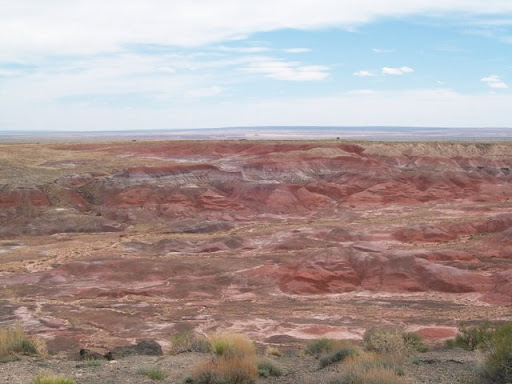
The Painted Desert and the Petrified Forest are actually part of the same National Park, which straddles the old passage of Route 66. The park is about 30 miles from end to end, and we came upon it from the Painted Desert side. Our first stop was the visitor center, at which we bought our customary smushed pennies and Danielle picked up her very own piece of petrified wood. It is illegal to remove wood from the National Park, but many specimens from other locations (private land, for example), find their way into the gift shop, as it serves as an obvious location for many people that might be interested in such a souvenir. Danielle actually ended up with two pieces from that day, both purchased legally in gift shops, that ended up putting her checked bag very close to the allowable limit on the way home (petrified wood is not light). We then set about "hiking" the Painted Desert Rim Trail, which is basically a concrete walkway that overlooks some of the more picturesque sections of the park and winds around to the Painted Desert Inn, which to be blunt was very disappointing. The top floor was basically a book store with some large framed pictures on the walls detailing the history of the inn. The bottom floor resembled the basement level rec room of a church, complete with spiderwebs and non-functional sinks. Needless to say we moved along quickly, stopping outside to look at the scenic overlook point (where we ran into a junior ranger in training and his grandparents) before retracing our steps back to the Highlander. Along the way we took some more pictures and learned a good deal about the local flora and fauna by way of small wooden signs along the trail. We also noted that my shoes were quite the worse for wear.
 Once we got back to the Highlander, we loaded up and drove about halfway through the park, stopping for a short hike to Puerco Pueblo and Newspaper Rock (not the Newspaper Rock as my little google search just now is telling me...rather just a Newspaper Rock). The pueblo was interesting, and it was augmented with signs that gave information about the people who lived there, why they left, and how they survived in the forbidding environment around us. Newspaper rock was also quite cool, with literally hundreds of pictographs all in one place (and even one that you'd swear looked like a stork delivering a baby, which obviously makes absolutely no sense whatsoever). They even had one of those view finder things that allowed you to get a closer look at what appears to be a pushmi-pullyu (which is apparently something from Dr. Doolittle that I'd never heard of), which, again, makes no sense whatsoever.
Once we got back to the Highlander, we loaded up and drove about halfway through the park, stopping for a short hike to Puerco Pueblo and Newspaper Rock (not the Newspaper Rock as my little google search just now is telling me...rather just a Newspaper Rock). The pueblo was interesting, and it was augmented with signs that gave information about the people who lived there, why they left, and how they survived in the forbidding environment around us. Newspaper rock was also quite cool, with literally hundreds of pictographs all in one place (and even one that you'd swear looked like a stork delivering a baby, which obviously makes absolutely no sense whatsoever). They even had one of those view finder things that allowed you to get a closer look at what appears to be a pushmi-pullyu (which is apparently something from Dr. Doolittle that I'd never heard of), which, again, makes no sense whatsoever.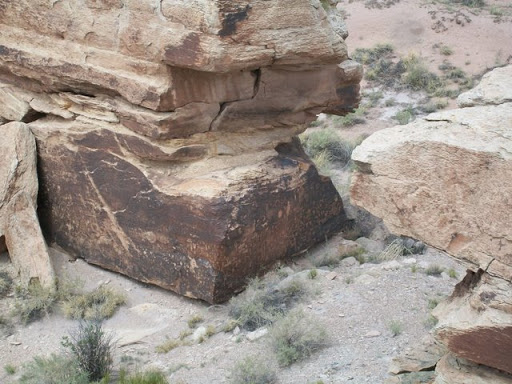
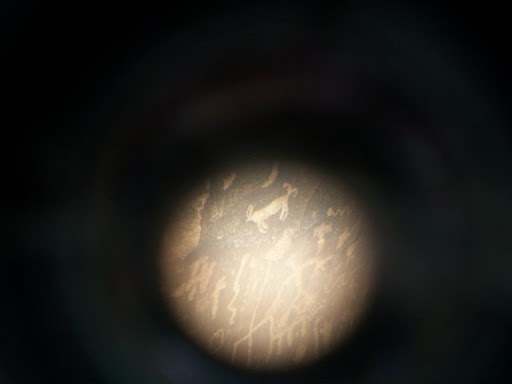 After the pueblo and the pictographs, it was back in the Highlander for a drive across the rest of the park to the hike the Blue Mesa Trail, which felt like walking through a construction site dump, with the addition of thousands of pieces of petrified wood of all shapes and sizes literally strewn everywhere. We learned on this trip that the "petrification process" is actually a really simple one. In this case, the specimens we saw around us fell into a river and were carried to where were standing, which at the time was a large lake/bog/generally wet place. They became waterlogged and eventually sunk to the bottom and were covered by sand and silt. In this oxygen free environment, and under pressure, the logs were eventually petrified by way of silicon replacing the plant matter literally atom by atom.
After the pueblo and the pictographs, it was back in the Highlander for a drive across the rest of the park to the hike the Blue Mesa Trail, which felt like walking through a construction site dump, with the addition of thousands of pieces of petrified wood of all shapes and sizes literally strewn everywhere. We learned on this trip that the "petrification process" is actually a really simple one. In this case, the specimens we saw around us fell into a river and were carried to where were standing, which at the time was a large lake/bog/generally wet place. They became waterlogged and eventually sunk to the bottom and were covered by sand and silt. In this oxygen free environment, and under pressure, the logs were eventually petrified by way of silicon replacing the plant matter literally atom by atom.
 The hike through the Blue Mesa area was only a few miles long (perhaps three), and the weather was very amenable (it was cool and overcast....this was the only day of the trip on which we actually got hit by a little bit of rain). The theme was basically looking at one astonishing piece of petrified wood after another. Some of them, like the piece above, looked exactly like a tree stump from ten feet away. You had to get very close to most of the specimens to tell you weren't just looking at a piece of a tree that had fallen on the ground ("From what tree, exactly?" would be a fine question, as there weren't any as far as the eye could see). Some pieces, however, were so colorful that it was impossible to mistake them for anything but stone.
The hike through the Blue Mesa area was only a few miles long (perhaps three), and the weather was very amenable (it was cool and overcast....this was the only day of the trip on which we actually got hit by a little bit of rain). The theme was basically looking at one astonishing piece of petrified wood after another. Some of them, like the piece above, looked exactly like a tree stump from ten feet away. You had to get very close to most of the specimens to tell you weren't just looking at a piece of a tree that had fallen on the ground ("From what tree, exactly?" would be a fine question, as there weren't any as far as the eye could see). Some pieces, however, were so colorful that it was impossible to mistake them for anything but stone. After the hike we stopped at an overlook from which you could see almost the entire area we'd just walked through. We got to read about a man who had visited the park twice, nearly 60 years apart, and had taken pictures from identical spots on the very spot where we were standing. The pictures were striking, in that erosion really had run it's course on a very human time scale. The hills in the background looked very different in the second picture (taken with his grandson) than the first (taken when he was a child). Neat. Very geek, but also very neat.
After the hike we stopped at an overlook from which you could see almost the entire area we'd just walked through. We got to read about a man who had visited the park twice, nearly 60 years apart, and had taken pictures from identical spots on the very spot where we were standing. The pictures were striking, in that erosion really had run it's course on a very human time scale. The hills in the background looked very different in the second picture (taken with his grandson) than the first (taken when he was a child). Neat. Very geek, but also very neat.The next stop was a second visitor center, this one on the other side of the park (the site of Danielle's second petrified wood purchase, and, now that I think about it, our smushed pennies. The old man who ran the store spent what felt like 15 minutes explaining to us why it was better to use older pennies than newer ones, and told us a story about play-acting a riot scene in San Francisco, which apparently people did back in, jeeze, he was real old, like the 50s or something). Also, the small matter of lunch was taken care of by delicious chocolate chip cookie ice cream sandwiches. It's funny now that I think about it. On the first 4 nights of the trip we treated ourselves to delicious steak dinners. Over the course of the last 36 hours, however, we'd eaten two meals in the car and had taco bell and ice cream for lunch.

Lunch in tow (and petrified wood in the Highlander), we moved from the gift shop to the actual visitor center for our first (and only) ranger talk of the trip. The visitor center itself had all kinds of cool stuff to look at, including complete (with missing pieces replicated) skeletons of a few extinct species that had lived in this badlands area millions of years ago. Specifically there was a skeleton of what looked like a crocodile, and another that literally resembled the animal version of a tank, a large herbivore with plated armor surrounding it's entire abdomen. For the life of me I couldn't figure out how this creature could have supported it's own weight, and our ranger wasn't a whole lot of help on the matter. The indoor portion of the talk was brief, after which we headed outside to hunt for fossils. Our ranger (a woman who was working as part of a transfer program with some university in Europe) taught us the all important lick-test. Apparently, if you find something that you suspect might be a fossil, the most definitive and expedient way to tell is simply to lick the thing. If it sticks to your tongue, you've got a dino bone. Otherwise, it's just another rock. Danielle and I both eventually managed to find a fossil (which we confirmed with the lick test), and the teenage boy in group found something like half a dozen. After 20 minutes or so, the official talk was over, and Danielle and walked the trail near the visitor center before setting out for another hike (or two...by this point our day was pretty free flowing, with us just planning to see as much as we could and still leave time for tonight's attraction).
 The hike we settled on called Long Logs, mainly because it meandered past some very long petrified logs that had fractured into pieces (as if cut by a chain saw), but still very much resembled the trees they used to be. On the path that lead to the beginning of the hike we spotted a horned lizard and managed to take a picture. Later in the day we ran into our ranger and told her about it; apparently she'd been telling people there were no such lizards in the park, and upon seeing our picture proclaimed "Now I have to walk over there and try to find him!" The Long Logs hike did not disappoint, as we did in fact walk past a ton of very long petrified logs.
The hike we settled on called Long Logs, mainly because it meandered past some very long petrified logs that had fractured into pieces (as if cut by a chain saw), but still very much resembled the trees they used to be. On the path that lead to the beginning of the hike we spotted a horned lizard and managed to take a picture. Later in the day we ran into our ranger and told her about it; apparently she'd been telling people there were no such lizards in the park, and upon seeing our picture proclaimed "Now I have to walk over there and try to find him!" The Long Logs hike did not disappoint, as we did in fact walk past a ton of very long petrified logs. The "destination" of the Long Logs hike was Agate House, a mostly reconstructed house built almost entirely out of, you guessed it, petrified wood. The house was originally built around 900AD, and by the time the US park service found it had fallen into considerable decay. This was back before the standard operating procedure was to leave things be, however, so the rangers decided to rebuild the thing, attempting to make it look like they thought it might have nearly 1000 years ago. The result was actually rather impressive, making me kind of wonder about the new policy of leaving piles of rocks as you found them.
The "destination" of the Long Logs hike was Agate House, a mostly reconstructed house built almost entirely out of, you guessed it, petrified wood. The house was originally built around 900AD, and by the time the US park service found it had fallen into considerable decay. This was back before the standard operating procedure was to leave things be, however, so the rangers decided to rebuild the thing, attempting to make it look like they thought it might have nearly 1000 years ago. The result was actually rather impressive, making me kind of wonder about the new policy of leaving piles of rocks as you found them. During the walk back Danielle and I ended up chatting about our high school days, talking about AP tests, Science Olympiad, Quiz Bowl, and all manor of other dorky pursuits that dominated our teenage years. Actually, none of that stuff dominated my years, as really the only thing I did from age 12 to 16 was swim. Apparently, her high school had just been deemed officially awesome (being ranked in the top 1300 schools in the country, or the top 2.5%), while mine...well let's just say it doesn't have a Wikipedia page. Right towards the end of the walk we were hit with the aforementioned rain (just a sprinkle) before getting back in the Highlander. We headed over to see Crystal Forest and Jasper Forest (which is where we actually ran into our ranger), determined that at a certain point one could only look at so many petrified logs, and got back into the Highlander for our trip to the Wigwams. That's right, we were going to sleep in a Wigwam!
During the walk back Danielle and I ended up chatting about our high school days, talking about AP tests, Science Olympiad, Quiz Bowl, and all manor of other dorky pursuits that dominated our teenage years. Actually, none of that stuff dominated my years, as really the only thing I did from age 12 to 16 was swim. Apparently, her high school had just been deemed officially awesome (being ranked in the top 1300 schools in the country, or the top 2.5%), while mine...well let's just say it doesn't have a Wikipedia page. Right towards the end of the walk we were hit with the aforementioned rain (just a sprinkle) before getting back in the Highlander. We headed over to see Crystal Forest and Jasper Forest (which is where we actually ran into our ranger), determined that at a certain point one could only look at so many petrified logs, and got back into the Highlander for our trip to the Wigwams. That's right, we were going to sleep in a Wigwam! Upon our arrival the clerk running the show, whose father apparently built the place, invited us to take a look at his private collection. I wasn't expecting much through the small wooden door in the back of the office in which he was watching an episode of Star Trek, Next Generation, but apparently I should have been. The man had probably half a million dollars worth of petrified wood (some of the pieces we saw at Bryce were offered for $20,000....this guy had at least 20 pieces, many of which were even more impressive), which didn't even dominate the room!
Upon our arrival the clerk running the show, whose father apparently built the place, invited us to take a look at his private collection. I wasn't expecting much through the small wooden door in the back of the office in which he was watching an episode of Star Trek, Next Generation, but apparently I should have been. The man had probably half a million dollars worth of petrified wood (some of the pieces we saw at Bryce were offered for $20,000....this guy had at least 20 pieces, many of which were even more impressive), which didn't even dominate the room!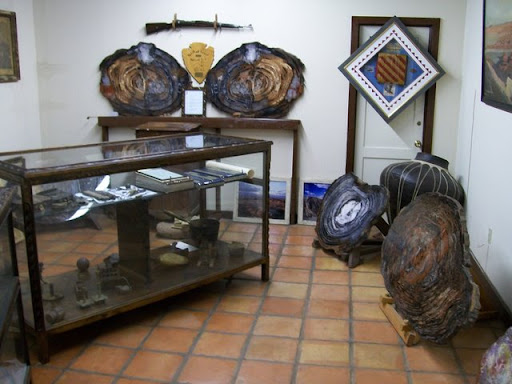 He had arrowheads. Literally hundreds. He had old license plates. Dozens. He had artwork of all kinds, including an original sketch of the Andersonville Civil War Prison Camp done by an artist who'd spent time imprisoned there. Rifles. Bullets. Medals. The small room was just packed with so much history of so many kinds I was beside myself. In retrospect, in a trip filled with great experiences, the 15 minutes we spent in this room was definitely one of the highlights. After an appropriate amount of gawking we made our way to our specific Wigwam, number 2 as it were, which had one of the many antique cars (apparently on loan) parked outside it.
He had arrowheads. Literally hundreds. He had old license plates. Dozens. He had artwork of all kinds, including an original sketch of the Andersonville Civil War Prison Camp done by an artist who'd spent time imprisoned there. Rifles. Bullets. Medals. The small room was just packed with so much history of so many kinds I was beside myself. In retrospect, in a trip filled with great experiences, the 15 minutes we spent in this room was definitely one of the highlights. After an appropriate amount of gawking we made our way to our specific Wigwam, number 2 as it were, which had one of the many antique cars (apparently on loan) parked outside it.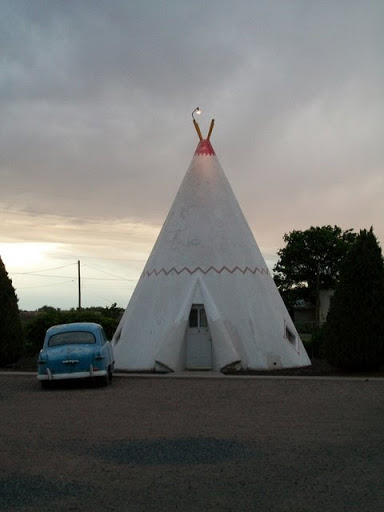 After settling in (the inside of the Wigwam was, unsurprisingly, a bit cramped), we decided that dinner would be two buildings away at the Butterfield Stage Coach Steak House. Curiously, after spending the last week hiking upwards of 15 miles a day, we opted to drive the 500 or so odd feet. With the possible exception of the meal at Phantom ranch a week earlier, this was probably the best meal we had all trip. The atmosphere of the restaurant was fantastic; a lone guitarist played live music for almost our entire meal (actually hitting on several songs we both liked), and the steak and ribs were both excellent. The decor was incredibly corny, which was exactly the sort of thing we were looking for. Each table had a sign made up with pictures and text about some legendary character or aspect of life in the wild west. The signs were so interesting that after we finished our meal we walked around the restaurant reading the ones at vacant tables (which happened to be almost every one, another reason we had such a great time). Eventually we drove the tenth of a mile back to the Wigwam and fell deep asleep, happy we'd been lucky enough to experience a little bit of Americana.
After settling in (the inside of the Wigwam was, unsurprisingly, a bit cramped), we decided that dinner would be two buildings away at the Butterfield Stage Coach Steak House. Curiously, after spending the last week hiking upwards of 15 miles a day, we opted to drive the 500 or so odd feet. With the possible exception of the meal at Phantom ranch a week earlier, this was probably the best meal we had all trip. The atmosphere of the restaurant was fantastic; a lone guitarist played live music for almost our entire meal (actually hitting on several songs we both liked), and the steak and ribs were both excellent. The decor was incredibly corny, which was exactly the sort of thing we were looking for. Each table had a sign made up with pictures and text about some legendary character or aspect of life in the wild west. The signs were so interesting that after we finished our meal we walked around the restaurant reading the ones at vacant tables (which happened to be almost every one, another reason we had such a great time). Eventually we drove the tenth of a mile back to the Wigwam and fell deep asleep, happy we'd been lucky enough to experience a little bit of Americana.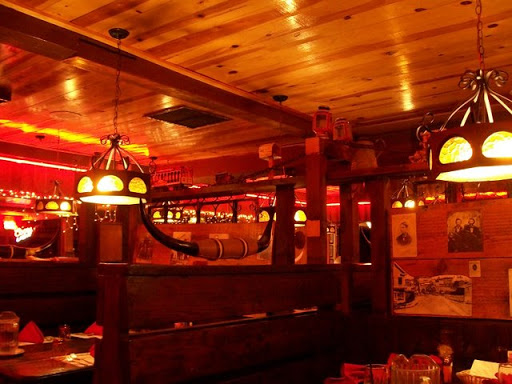
3 comments:
The "lick" test is definitely a level
Google "lick test fossil".
Admittedly the second result is this blog, but otherwise the results seem somewhat legitimate.
Enjoyed this blog so much Jesse! I felt like I was there, too! Thanks! Diana
Post a Comment